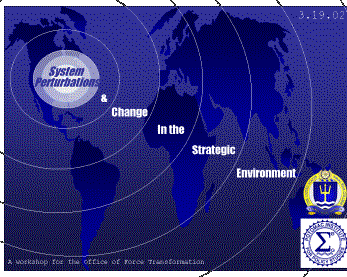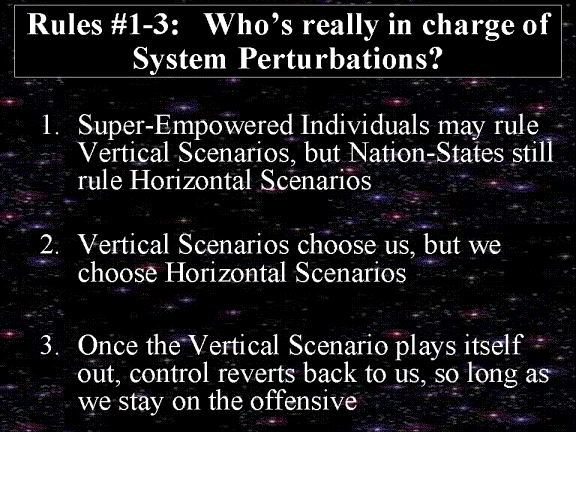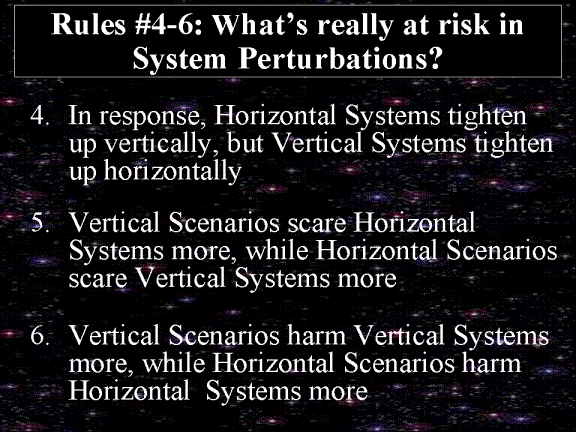COVID as System Perturbation (Part 1 of 2)
The ultimate horizontal scenario forever changed our horizontal political system, helping to radically nationalize all politics -- to our detriment
Back when I was working as Art Cebrowski’s Assistant for Strategic Futures in the just-stood-up Office of Force Transformation (directed by Art) in the Office of the Secretary of Defense (OSD) in the weeks following 9/11, I designed and convened a workshop to examine “system perturbations” as an appropriate model of crisis in a networked world.
I invited everybody I knew and respected on such systems-level thinking (chaos, complexity, etc.). The group included:
Arthur Cebrowski, Office of Force Transformation
John Garstka, Joint Chiefs of Staff C4 Directorate
Stuart Umpleby, George Washington University
Douglass Carmichael, Big Mind Media
John Petersen, The Arlington Institute
David Gordon, National Intelligence Council
Stephen Schlaikjer, Political Advisor to Chief of Naval Operations
Shane Deichman, JFCOM
Ahmed Hashim, Naval War College
Daniel Pipes, Middle East Forum/N.Y. Post
Jeff Cares, Alidade Consulting
Richard Landes, Center for Millennial Studies
Kori Schake, National Defense University
Joshua Epstein, Brookings Institution
Mitzi Wertheim, The CNA Corporation
Tony Pryor, International Resources Group
Hank Gaffney, Center for Strategic Studies
Yaneer Bar-Yam, New England Complex Systems Institute
Lee Buchanan, consultant
Bill Halal, George Washington University
Adam Siegel, Northrop Grumman
Cdr. John Dickman, CNO Strategic Studies Group
John Landry, National Intelligence Council
Jerry Hultin, Stevens Institute of Technology
It was a one-day workshop where all participants entered in their ideas via a dedicated LAN using the old GroupSystems platform and then followed-up each brainstorming session with facilitated discussion led by me. We tackled the following agenda (edited down to its bare essentials):
AGENDA FOR 19 MARCH SYSTEM PERTURBATIONS WORKSHOP
Warm-up: You are asked by the Mayor of New York City to pen a paragraph on the significance of 9/11 for inclusion in a time capsule to be buried beneath the permanent memorial being erected at Ground Zero in lower Manhattan.
Please give us examples of System Perturbations in history and explain what each example tells us about this concept. Enter your ideas into 6 separate "buckets":
Economics
Politics
Technology
Environment
Cultural/media
Security
Give us your description of the defining global conflict paradigm for the next 10-to-20 years. You will be given four, admittedly overlapping "buckets" to choose from in terms of placing your entry:
Division by competency/success
Division by culture/civilization
Division by great power-led camps
Division by ideology
What are the new rule sets that emerge as a result of 9/11 and the ongoing GWOT? You will be asked to enter your ideas into 3 separate "buckets":
Security within our borders
Security at our borders
Security beyond our borders
What will future enemies of the U.S. learn from 9/11 and the GWOT? You will be given three "buckets" to choose from in terms of placing your entry:
Super-empowered individuals
Transnational networks
Nation-states.
What are the long-term institutional ramifications of the home game/away game dichotomy? You will be asked to enter your ideas into 3 separate "buckets":
A future Department of Homeland Security will someday rival DoD in importance
DoD will remain the predominant national security player in all spheres
DoD will bifurcate into a classic warfighting force and a constabulary force
Building the System Perturbation model piece by piece: You will be asked to participate in 6 sequential 20-minute sessions exploring each phased category. The six proposed categories are:
Agents
Triggers
Medium
Transmission
Barriers
Consequences
You will be asked to participate in 3 sequential 30-minute sessions exploring three broad questions:
In responding to future System Perturbations, how much responsibility falls to DoD versus the rest of the US Government?
How much falls to the public sector versus the private sector?
How much falls to the United States versus the rest of the world?
Each 30-minute session will begin with facilitated discussion and end with another GroupSystems brainstorming activity where you will be asked to suggest useful steps the US Government could take in the coming years to meet the challenges associated with future System Perturbations such as 9/11.
Apologies for all the background, but it allows me to replicate the material for long-haul storage (and retrieval) here on Substack.
First, the definition of System Perturbation that I used in my books and work at OFT:
System Perturbation
A system-level definition of crisis and instability in the age of globalization; a new ordering principle that has already begun to transform the military and U.S. security policy; also a particular event that forces a country or region to rethink everything. The terrorist attacks of 9/11 served as the first great “existence proof” for this concept, but there have been and will be others over time. Some are purposeful, like the Bush administration’s Big Bang strategy of fomenting political change in the Middle East, but others will be accidents, like the Asian tsunamis of December 2004, or America’s recent financial crises.
Next, the definitions of Vertical and Horizontal systems I used in this workshop:
Pretty basic stuff that allows us to explore political systems without the normative baggage of free-v-unfree, thus being able to spot an essentially vertical system that pretends to be a democracy.
The US is, of course, a horizontal system — a federated republic.
NOTE: Below I’ll re-interpret the “rules” I pulled from this workshop vis-a-vis COVID. It you want to read my original analysis, which failed to get into any of my books (too abstract), then go to this old archived blog post (assuming this link works for people other than me, and why it works for me still … I do not know).
So, finally, the rules, re-interpreted per COVID;
Rule #1: Super-empowered individuals may rule vertical scenarios, but nation-states still rule horizontal scenarios
Many of us remember COVID-19 like this bolt from the blue, but it was really a Horizontal Scenario that came on like a flood — incremental and distant until the water hit your home and then everything felt very vertical in that moment (elevating from abstract threat to very real and close-in threat). One strong memory for me: the NBA Jazz-Thunder game cancelled just before tip-off over one player testing positive.
At that point, the cancellations poured in like the dam broke — again, seeming very vertical (out of nowhere) in the moment, but clearly just the start of a very long horizontal scenario with all manner of twists and turns and plot shifts and surprises.
Yes, we immediately searched for guilty individuals (a Patient Zero like Gwyneth Paltrow’s character in the movie Contagion), or that one wet-market merchant in China, or that one sloppy lab person at the Wuhan research lab … believing, as we do, that there must be the super empowered (even if only inadvertently) individual who started it all like a fire in the woods.
But, true to form for a Horizontal Scenario, there is no clear beginning and no clear end, so the mystery remains and continues to be argued over.
Rule #2: Vertical scenarios choose us, but we choose horizontal scenarios
As noted above, humans were put in this odd position of choosing to respond. Unlike, say 9/11, when the sheer shock of the vertical scenario compelled response, with COVID we sort of got to choose how seriously to take it all in — at least in the jokey, weird, early days.
Rule #3: Once the vertical scenario plays itself out, control reverts back to nation-states, so long as they stay on the offensive
Once like it seemed like COVID was everywhere and beyond any doubt, we regrouped as communities and states and started to reclaim control, which, in this weird instance, necessitated a widespread lock-down until we got a better handle on transmission routes and immediate treatments. I mean, remember all the early guesses on transmission that turned out to be wrong? That was a real problem. Then there were all the de facto medical experiments run live on actual patients trying to figure out what kept them alive. It was, after all, a novel virus.
But the real key to regaining a sense of control and being back on the offensive was the whole Operation Warp Speed on the vaccine, initiated by Trump but later decredentialized by him as well with the whole choose-or-choose-not debate about receiving the vaccine, and then later claimed (rightfully) by Trump as his greatest single success in the whole disaster — amidst boatloads of bad choices and timing.
Rule #4: In response to System Perturbations, horizontal systems tighten up vertically, but vertical systems tighten up horizontally
This is where it gets interesting to this political scientist: horizontal systems like the US tend to tighten up vertically and suddenly it’s USG this and USG that, which always irritates the hell out of a solid chunk of Americans. Think bad to how powerful Fauci seemed and how much people both idolized and hated him.
Then there are places like China where the tightening up goes almost block by block, achieving lockdowns that America could never approximate.
Rule #5: Vertical scenarios scare horizontal systems more, while horizontal scenarios scare vertical systems more
In part, that’s because horizontal systems like the US fear vertical scenarios so much more than horizontal ones. We obsess over bolts from the blue when, in truth, we’re an impossible system to “decaptitate,” unlike a truly vertical system where the death of the dictator flattens everything overnight.
So, yeah, we blew off COVID in our minds: How bad could it get?
Pretty damn bad, it turned out.
Bad enough so China’s strong-arm tactics on a block-by-block basis paid some serious dividends — almost making us jealous and definitely making us that much more suspicious about China’s involvement.
Rule #6: Vertical scenarios actually stress vertical systems more, while horizontal scenarios actually stress horizontal systems more
The truth we should have learned is easy enough to state: horizontal systems like the US do great against bolts-from-the-blue, as we mobilize all our levels and can attack the problem strategically, operationally, and tactically —simultaneously across federal, state, and local levels.
It’s those damn horizontal crises that we have a hard time wrapping our minds and our responses around — so many jurisdictions and overlapping rulesets … who the hell is in charge? Should anybody be in charge? We don’t need no stinkin’ badges!
China, being so vertical, fears not the horizontal scenario that can be tamed by brute government force. It’s the surprising vertical scenarios that keep the Chinese officials up at night — like the proverbial earthquakes that used to topple ancient rulers over night in a sign from above, or Falun Gong appearing out of nowhere one day in Tiananmen Square.
Rule #7: Vertical scenarios are always preceded by horizontal scenarios that generated the preconditions for system shock
The vertical scenario that was the Great Lockdown was preceded by all manner of smaller signs that we were headed in that general direction, and yet, it still seemed totally shocking when it happened — almost inconceivable.
Rule #8: Vertical scenarios are invariable followed by horizontal scenarios that generate preconditions for future shocks
Once the Fed made the Great Lockdown decision, all manner of follow-on horizontal scenarios unfolded — triggering all manner of unexpected outcomes, like the run on pets, people going nuts working out, the sharp increase in home deliveries, restaurants reduced to take-out only, nobody going to movies but everybody binging on streamers, etc.
Again, all manner of weird outcomes that gradually unfolded as we adjusted to this ever-lengthening horizontal unfolding. What future shocks were later triggered? Trump not winning re-election for one, and then four years later Trump winning re-election. Both decision-points were profoundly enabled by COVID (first dooming him, then dooming Biden with follow-on inflation).
Plenty more where that came from, but you get the idea: twists and turning points in retrospect.
Rule #9: The potential for conflict is maximized when states with differing rule sets are forced into collaboration/collision/clashes
State-on-state clashes ensued, as the more vertical systems looked on in horror as the more horizontal ones didn’t match their strict policies. This was the microcosm that unfolded in air travel, where the rules were different just about everywhere. I can recall how much harder it was to get back into the United States from abroad — kind of presaging the reality of today.
Then there were the natural suspicions regarding vertical-system China as the starting point for the pandemic. How could such a controlled society let something like that happen — unless it didn’t happen by accident?
Rule #10: A strong offensive strategy can force a certain amount of structure on the most asymmetrical of enemies
COVID was entirely asymmetrical in its nonstop mutations, defying any one single answer or explanation. Eventually, states and governments had to step up big-time to force a certain tolerable structure on basically all human activity, resulting in those weird global effects like the planet’s plate tectonics growing more quiet because there was so much less human activity going on. The unprecedented drops in pollution and CO2 emissions also come to mind.
What a weird global experiment!
Rule #11: Our individual plays unfold with utmost speed, but in ignoring any "game clock," we remember that our strength is our inevitability
It did seem like we were jumping through our assholes on a daily basis: Do it this way! No, that turned out to be BS, so now do it that way! And so on.
There was clearly no game clock, which is why we all remember that period so poorly, as I wrote here earlier:
Rule #12: Our efforts to dissipate horizontal scenarios will invariably trigger unintended consequences that take on a life of their own.
This would be the long list of how COVID changed us permanently, which I’ll explore via an excellent NYT piece in Thursday’s Part 2 to this post.
Keep reading with a 7-day free trial
Subscribe to Thomas P.M. Barnett’s Global Throughlines to keep reading this post and get 7 days of free access to the full post archives.











